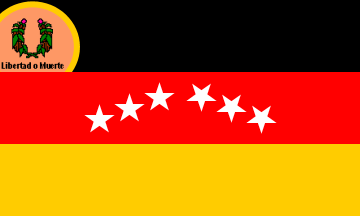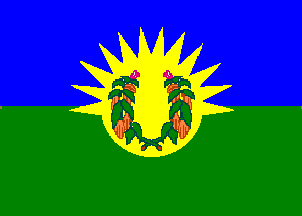 klaus-michael schneider
klaus-michael schneider
Keywords: miranda | venezuela | sun | tuy | cocoa | ship | coffee | chacao |
Links: FOTW homepage | search | disclaimer and copyright | write us | mirrors

Last modified: 2021-08-26 by  klaus-michael schneider
klaus-michael schneider
Keywords: miranda | venezuela | sun | tuy | cocoa | ship | coffee | chacao |
Links: FOTW homepage |
search |
disclaimer and copyright |
write us |
mirrors

image by Eugene Ipavec and Jose Manuel Erbez Rodriguez, 29 October 2006
See also:
Municipalities (Capitals):
Other sites:
According to report at <www.eluniversal.com>,
a new flag will be hoisted on 28 March 2006. The new flag is
reported as black-red-yellow. There is no confirmation from
another source and the official site <www.miranda.gov.ve>
still show the flag as above.
Valentin Poposki, 5 April 2006
Falcón and Miranda, recently adopted
new flags. Both have in common to be derivates from designs
created by
Generalissimo Francisco de Miranda: illustrious Venezuelan Hero
and Precursory of Latin American independence whose memory has
received tribute two hundred years after his liberating
expedition in which, by the way, was affirmed the Prioritized
Flag of Venezuela (horizontal tricolor yellow, blue and red) in
the leader ship "Leander" on March 12th, 1806, in
Jacmel Bay, Haiti, already on the eve of taking coursec to
Venezuelan coasts at which he arrived following August 3rd.
This commemoration has given rise to symbollogical changes signed
by the "rapidity" with which it has taken place,
leaving in doubt its legitimacy and therefore its transcendence.
All began on last March 9th with the official publication of the
new Law where one eighth star was added to National flag and
modified substantially the Coat of Arms of the Republic, which
it's also described like "Bolivarian".
Seven days after Falcón adopted new flag, on August 10th,
Miranda State also adopted new flag: due to its evident
similarity with the present Flag of Federal Republic of Germany
the promoters of the change - announced months ago and reviewed
into our allied forums - had to characterize it somehow and added
six five-pointed and stars placed in angle in such way that three
were oriented upwards and three downwards on the central stripe
for represent the six regions of the state whereas the sun of the
old flag now appears streamlined on the lateral superior canton
(attached to the mast) on the superior stripe loaded with two
branches of cocoa and including a legend (apparently,
"Freedom or Death": war voice that according is
commented El Libertador Simon Bolivar took for himself during the
War of Independence). The three stripes black, red and yellow
which initially were attributed the meaning of the union of
Blacks, Browns and Indians (the dominant races on Miranda's
Venezuela) for the emancipation now alludes to the same three
races that now integrate Mirandian community... Nevertheless,
also there are people of white race, as much in the state as in
all Venezuela due to our multiethnic wealth...
According referred the corresponding news, the now Mirandian flag
was approved "quickly" by Legislative Assembly like
part of the new Constitution of the state, so and as it's
indicates at <www.eluniversal.com>
where also it's says that "With this controversial legal
instrument, besides to release the name "Bolivarian State of
Miranda" also releases new symbols (end of mention)"
and adds soon (it's mentioned) "This is the true Flag of
Miranda, we are rescuing the Flag that brought Miranda to the
(Mother) country on 1800... The previous one didn't represent the
State, but to any part of the (Mother) country because the blue
was the sky and green the mountains", expressed Liliana
González, deputy pertaining to the sector that supports the
government. Nevertheless, the new flag is inspired by a project
(that is to say, it was never made reality in fabric) also
originated by the precursor whose approximate date is established
on 1800 referred in the Documents Catalogue of Archive of Indias
in Seville, Spain under the title of "Flag of Miranda for
his Army with the name of Columbian" ... Except
incontrovertible historical-graphical evidence, it never was
brought to the Homeland and when Miranda came effectively six
years later the flag of his independence movement was another
one: even though it has been tried to relate them, seems quite
probable that it didn't keep bonds each other...
Raul Jesus Orta Pardo, 22 August 2006
The Flag - Attributes and Semiology: Consist in a field with
approximated ratio 2:3; this is, square and half of length. Its
field is divided in three horizontal and equal stripes: the black
one (superior) represents Black people; the red one (central)
alludes to Brown population and the yellow one (inferior) reminds
the aboriginal people of the State. The six five-pointed and
white stars disposed in arc on the red stripe remember its six
sub-regions: Altos Mirandinos, Valles del Tuy, Sucre, Área
Metropolitana, Guarenas Guatire and Barlovento. The sun on the
canton the warm coast and beaches of the entity whilst the cocoa
branches represents the agricultural riches of its ground, all
reaffirmed with the motto “LIBERTAD O MUERTE” (“Freedom
or Death”) which it’s says El Libertador Simón Bolivar
takes for himself on the Venezuelan War of
Independence.
- Historical Synthesis: It was approved as a part of the
Constitution of Bolivarian State of Miranda on July 25th, 2006
and enthroned by Governor Diosdado Cabello on next August 12th.
It’s necessary to mention that the initial proposal included
three stars oriented upwards and three downwards disposed in
angle on the red stripe.
Sources: Web
Site Gobernment of Miranda State, Diario
El Universal (Daily El Universal) Diario “Tras la
Noticia” ” (Daily “Following News”) August
2006.
Raul Jesus Orta Pardo, 15 February 2007
See also: Venezuela - Historical Flags

image by Guillermo Aveledo, 18 August 2000
Miranda, is one of central northern and coaster state of
Venezuela and its was named in honor to the
"Generalissimo" (Great Field Marshall) Francisco de
Miranda, one of the most illustrious Venezuelan heroes and
precursor of South American Independence, who takes part in the
French and the American Revolutions. The Miranda State flag is
divided in two horizontal and equivalent stripes: the blue
(above) represents the "Tuy", the most important river
of the state, whilst the green stripe (below) symbolizes the
fertile grounds of the region. The rising sun reminds the warms
coast and beaches of the entity and the cocoa branches represents
the agricultural riches of the land. The Mirandian Coat of Arms
is divided per bend. The first quarter (above) shows a ship over
quiet sea representing the commerce. The central bend in vert
(green) symbolizes the hope whilst the silvered star in the top
remind the peace. The third quarter (below) presents a natural
landscape with the Tuy River in the middle of a forest with
cattle represents the riches of the land. The cornucopias
crowning the shield are symbols of abundance. The sugarcane,
coffee and cocoa branches at its sides are the principal
agricultural products of the state and the three-colored pennant
charge how mottoes the followings ephemeris "5 de Julio de
1811" (July 5th, 1811) "20 de Febrero de 1859"
(February 20th, 1859) and "14 de Febrero de 1814' (February
14th, 1814).
Raul Jesus Orta Pardo, 19 July 2000
Here is image of the flag
as it appears at the official site <www.miranda.gov.ve>.
Pablo Acosta Rios, 3 October 2002
miran.jpg)
image by Raul Jesus Orta Pardo, 15 February 2007
Coat of Arms - Attributes:
The Mirandian Coat of Arms consists in a Germanic shape filleted
in Or and divided per bend; this is, with two diagonal quarters.
The Sinister Quarter of the Chief enameled in Or (yellow) shows a
sailboat sailing on a quiet sea accompanied by a “curiara”
(typical aboriginal boat) guided by two indians. The Dexter
Quarter of the Base enameled in Argent shows a natural landscape
with a river in the middle of a forest with cattle and the
silhouette of mountains. Over all, a Bend (heraldic piece which
consist in specie of stripe diagonally disposed from the Dexter
Chief to the Sinister Base) enameled in Gules (red) charges a
five-pointed star in Argent (white) on the Dexter Canton of the
Chief. As External Ornaments, the blazon presents two cornucopias
in Gules upsetting its fruits as crest and as supports, branches
of coffee and cacao to the dexter and another of sugar cane at
the sinister jointed by means of a pennant enameled in Sable
(black), Gules (RED) and Or (yellow) charging as mottoes the
following ephemeris “5 DE JULIO DE 1811” (“July
5th,1811”); 1° de FEBRERO DE 1817” (“February 1st
,1817”) and “3 DE AGOSTO DE 1806” (“August
3rd , 1806”).
- Semiology: The First Quarter alludes to the commerce whilst the
curiara and its conducers represent Cacique (Indian Chief)
Guaicaipuro and his warriors. The Second Quarter reminds two
landmarks of the regional geography: the Tuy River and the
Coaster Ridge symbolizing, besides, the agriculture and the
wealth of the ground. The Bend represents the Hope and the Star
symbolizes the Peace. The Cornucopias reminds the Abundance. The
Coffee, Cocoa and Sugar Cane branches rebounds the main
agricultural products of the region. The ephemeris reminds
respectively the date when was signed the Act of Independence of
Venezuela; the date when was born General Ezequiel Zamora, Hero
of Venezuelan Federal War and the date when Generalissimo
Francisco de Miranda arrives to Vela de Coro.
- Historical Synthesis. It was approved as a part of the
Constitution of Bolivarian State of Miranda on July 25th, 2006.
Sources: Web
Site Gobernment of Miranda State.
Raul Jesus Orta Pardo, 15 February 2007




